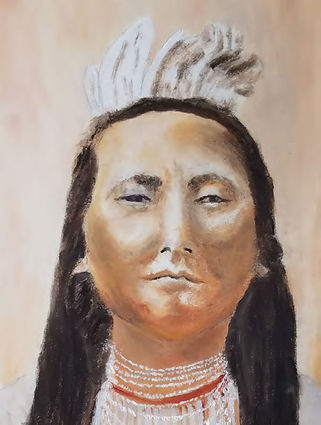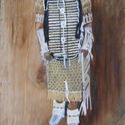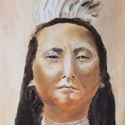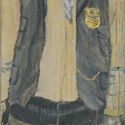MONTANA'S FIRST IMMIGRANTS
Three Distinguished Members of the Crow Nation
July 1, 2020
Discussing these gentlemen in chronological order gives some important snapshots of the tribe beginning with a little before their occupation of the Reservation we know until the present day.
The first of these, remembered in Jane's recent painting done for this article, is Plenty-Coups, whose name all of us have seen on road signs around Billings, but what have we learned about this remarkable leader of the Mountain Crow and one of the worthiest Native Americans in the annals of the United States?
He was born "Buffalo Bull Facing the Wind," while his later, Indian name may be translated "Many Achievements," and we recall from our first article on the Crow that a coup was an act of bravery in warfare. Because of that word, we can expect that "Plenty-Coups" was another French translation, so perhaps his name was partially earned by some admired accomplishments on fields other than battle. This was certainly true of his later life.
He was born near Billings in 1848, and we recall that the treaty defining the Reservation was signed in 1868. Apparently, he was a precocious child, for at age 11 he, along with other young men of the tribe, was challenged by the elders to experience a vision to guide their people's future. According to the pattern noted in our installment on Crow religion, he fasted and spent several days alone in the Crazy Mountains.
He was rewarded with a complicated vision that he returned and reported. In a part of it the Plains were covered by a multitude of exotically-colored bison, all of which disappeared down a hole. He saw himself as an old man, and there was a forest in which strong winds blew down all the trees save one, the home of a chickadee.
Wise men of the tribe interpreted this to mean that the bison would disappear and that white people would take over the Indians' lands and way of life. The tree surviving the windstorm represented the Crow, who would be spared if they learned to work with the white man, which was exactly the policy Plenty-Coups would follow in his later life.
True to convention, he fashioned medicine to strengthen his bond with the spirits; in his medicine bag he always carried a pair of chickadee legs.
Elected by all other chiefs, Plenty-Coups became the last hereditary Head of the Mountain Crow in 1876, the year of George Custer's massacre by the Sioux and proceeded to become an articulate spokesman for Native Americans. In 1921 he was their sole representative at the dedication of the Tomb of the Unknown Soldier, now denominated the Tomb of the Unknowns. There he gave a speech in his own language and placed his war bonnet and coup stick as an offering on the tomb. Both these mementos are preserved there in a display case.
A great proponent of education as the means for his people's ascension, he once said, " ... there is only poverty and misery in idleness and dreams – but in work there is self-respect and independence." This valuable advice should be broadcast loudly to large segments of contemporary Americans. The wise Chief passed away in 1932.
The federal government asked Plenty-Coups to appoint the first Native police officer on the Reservation. His selection was Bear Claw, and Jane's painting, "Sheriff Bear Claw," was executed on a narrow plank of barn wood to emphasize the man's slender build, and from that medium's texture and color the Sheriff's complexion materializes in a natural, accurate way.
All that is known about his tenure is that he had to have been appointed in or after 1876, and he was proud of his stature as sheriff. In an unusual twist to culminate Bear Claw's career, his badge vanished at the time of his death but was discovered years later in Texas.
Shikaakkate, a member of the Greasy Mouth Clan and a child of the Big Lodge Clan, is a nickname in the Crow language for Albert L. Gros-Ventre, Jr. His actual, Indian name, Illlapichilkaashe, means sharp-shooter and was given him by his great-great grandfather, the late William Gros-Ventre, a veteran of World War II.
Jane used this young man, whom we met at an exhibition where the painting was shown, to illustrate Crow ceremonial dress and elements of their traditional culture. As with Sheriff Bear Claw, choosing the wood so as to convey the person's coloring contributed to the design.
Shikaakkaate is dressed in traditional Crow Hot Dance regalia. Throughout the Plains, the Crow were distinct in their styles of dress. The head piece, known as a roach, is made of porcupine hair and deer tail with two eagle feathers standing on top. The male dancers of the Crow wear matching aprons and breechcloths, choker, breastplate, armbands, cuffs, mirror case, belt, buckle, and footwear. Most of the beadwork is also matching, and we observed previously that the tribe was long-noted for its intricate beadwork. The side bells, along with angora and ankle bells, run from the hip belt to the ankles. Some of the male dancers carry a fan or a decorated, dancing stick, which may also function as a whistle.
The purpose of the ceremonial dance is to tell Mother Earth that they enjoy being alive and well. Therefore, the men and boys dance by kicking the ground and making noise with singing and beating a drum.
The costume, the dance, all have very formal patterns to follow, but even the presentation of the dance has its conventions. According to Crow tradition, when a male dancer is ready to take the floor for the first time, he is escorted by an accomplished dancer or someone selected by the family, and together they dance to a personal or family song. Once the inaugural performer has made one complete revolution of the floor, the family will honor him with a "giveaway" to Clan fathers and Clan mothers. After that is complete, he is permitted to go to the dancing floor whenever he chooses. Shikaakkate was not a year old when he was taken to perform his first dance to his great-great-grandfather's song "Harry Beads Don't Mix," sung by the Night Hawk Singers of the Valley of the Chiefs, Lodge Grass.

Jane Stanfel
Sheriff Bear Claw - Oil on Old Barnwood
We conclude the brief glimpse of our Crow neighbors and hope readers have enjoyed the articles as much as we have in presenting them. Next week, we return to latter-day Montanans and tell you about a settlement that may be new to you.






Reader Comments(0)